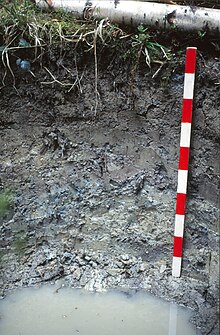Pseudogley

The Pseudogley is in German and central European soil systematics of the most important type of the class of backwater floors . Outdated names are Staugley, Staunässegley, wet forest floor or gley-like floor. The soils of this soil type are characterized by a change from seasonal waterlogging and relative drying out. The pseudogley differs from the gleya , the formation ( gleying ) of which is caused by groundwater in the soil. He is - under the name backwater ground to - bottom of the Year was proclaimed, 2015.
Emergence
Water stagnation arises from the fact that there is a suddenly less water-permeable horizon in the soil profile. This can be the case at a layer change caused by sedimentation, but also through so-called embedding compaction, in which clay particles in the soil profile are shifted downwards ( lessivation ) and the cross-section of the pores in the then clay-enriched horizon are reduced. The water displaces the soil air from the pores. The oxygen in the rainwater is used up by the soil microorganisms relatively soon and reducing conditions arise under which iron (III) and manganese (IV, III) are reduced with simultaneous oxidation of organic matter to Fe (II) and Mn (II). In a reduced form as Fe 2+ or Mn 2+ , they are mobile in the soil solution. They also get into the interior of the soil aggregates through diffusion. Here, in horizons saturated with backwater, soil air is often trapped, so that iron and manganese are oxidized again. The concentration gradient is preserved. Over time, bleached outer areas of the aggregate form on the one hand and rust-colored to black iron and manganese (hydr) oxide spots or concretions inside the aggregate on the other.
use
Pseudogleye are problematic locations in spring because of the waterlogging and the associated lack of oxygen and are mainly planted with forest or used as meadows. The forests are often poorly growing because the roots of the trees avoid the seasonal low-oxygen horizons and accordingly only have shallow roots. If in the course of the year the backwater finally seeps away or has been absorbed by the plants, they can then no longer absorb sufficient water through their shallow root system. In some cases, extensive drainage measures are necessary before the fields can be used. Loss or loss of income cannot be ruled out. Nonetheless , the pseudogleye created by embedding compaction from parabrown soils or pale soils are also useful arable sites.
Classification
In the German soil systematics, the damming horizon is designated with the horizon symbol Sd , the horizon above, in which the backwater is seasonal, with the symbol Sw . Soils with an S-horizon above 40 cm are called pseudogley; if the backwater conditions persist for a very long time, one speaks of stagnogleyen . In Haftpseudogleyen , backwater occurs without an actual storage horizon, but solely due to the grain size distribution and the pore size distribution caused by it. In the international soil classification World Reference Base for Soil Resources (WRB), the pseudogleye with an abrupt increase in clay content (i.e. most of the primary pseudogleye) belong to the planosols , which without such an abrupt increase ( i.e. most of the secondary pseudogleye) belong to the stagnosols .
distribution
Pseudogleye are widespread in Central Europe. They can be found both in the lowlands and in the low mountain ranges. In the moraine landscapes they are typical soils of the ground moraines . They are found there preferentially in the areas with more rainfall and near the coast (e.g. Lower Saxony, Mecklenburg-Western Pomerania). They are also common on the plateaus of the low mountain ranges, where clays, clay and siltstones are present or where in the Tertiary the tropical weathering led to clayey raw material of the Holocene soils.
literature
- W. Amelung, H.-P. Blume , H. Fleige, R. Horn, E. Kandeler , I. Kögel-Knabner , R. Kretschmar, K. Stahr , B.-M. Wilke among others: Scheffer / Schachtschabel : Textbook of soil science. 17th edition. Heidelberg 2018, ISBN 978-3-662-55870-6 .
- W. Ziechmann, U. Müller-Wegener: Soil chemistry. BI Wissenschaftsverlag, Mannheim / Vienna / Zurich 1990.
- G. Roeschmann: Pseudogley-Tschernoseme and their transition formations to parabroun earths in the loess area of the Hildesheimer Börde. In: Geological Yearbook. 85, Hannover 1968, pp. 841-860.
- E. Leitgeb, R. Reiter, M. English, P. Lüscher, P. Schad, KH Feger (eds.): Waldböden. An image atlas of the most important soil types from Austria, Germany and Switzerland . Wiley-VCH Verlag, Weinheim 2013, ISBN 978-3-527-32713-3 .
Web links
- Explanations of the pseudo-gleying. ( Memento from March 15, 2005 in the Internet Archive ) University of Zurich.
- Pseudogley on the website of the University of Münster
- Boden-des-jahres.de (Kuratorium Boden des Jahres)
- www.bodtypen.de/pseudogley/

